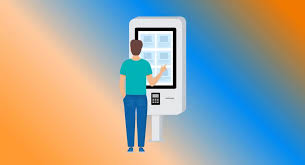The Psychology of Self Service: Why People Prefer Kiosks
Have you ever walked into a busy restaurant and, instead of heading for the queue, you’ve made a beeline for that glowing touchscreen? You’re not alone. The rise of the self service kiosk isn’t just a matter of convenience; it’s a fascinating look into consumer psychology and why, for many, the “human touch” is no longer the preferred way to get things done.
What seems like a simple transaction—tapping a screen instead of talking to a person—is a robust psychological exchange. Businesses have caught on to this, and they’re leveraging a few key human traits to make the self-service kiosk not just an option, but a truly compelling choice.
Autonomy Over Authority: Seizing the Experience:
Human beings need to feel that they are in control, even in small things like ordering lunch. Users experience a sense of empowerment when they are the users of a self service kiosk:
- They make their decision at their speed–no hurry, no compulsion.
- Customisations can be made easily and are confirmed easily.
- This prevents embarrassing mix-ups as errors may be corrected before submission.
Technically inclined or not, a kiosk allows the diner to take control into their own hands. And that autonomy creates satisfaction and loyalty.
Social Comfort: Privacy and Non-Judgment
Having to wait at a counter and discuss your allergy requirements or select from a limited range of sauces, while feeling like you are being observed, can be very stressful, particularly in crowded places.
Self service kiosks offer what is known in psychological terms as the social comfort factor:
- No need to describe dietary restrictions openly.
- No fear of either being slow to act or diversity in judging decisions.
- Less awkward to people who have social anxieties or are introverts.
Kiosks, in brief, have a built-in privacy buffer, and they make the invisible accommodations visible once again.
Choice Architecture: Directing Without Crowding
Decision fatigue is something that we have all felt. And just how variable can things get before your brain turns off? Successful self service kiosk interfaces are well-designed, ensuring that they are less overwhelming:
- Menus first prioritise the most marketed foods, and then extras have a button labeled “More Options.”
- Steps are divided into small pieces, and progress bars minimise frustrated progress.
- The visual signifiers of obvious images, big buttons, and uniform layout reduce cognitive load.
- Such factors guide a customer through the purchase process fairly, although the options allow for some perception of ease.
Reliability Cultivates Trust
We all experience the chaos of peak hours; lost orders, overworked staff, or table changes that are forgotten.
Kiosks are consistent:
- No disruption due to human tiredness or distraction during service.
- Never any lost upsells during rush hour.
- Non-variable workflow irrespective of personnel (regardless of the number of workers).
It is possible to doubt that people lack the charm of humanity, yet they prefer stability. And repeat customers have faith in a formula that consistently delivers results.
Gamified Gratification
Believe it or not, kiosks tickle a part of our brain that responds to small wins and instant feedback:
- Visual confirmation: “Order placed!” or “Thank you!” screens.
- Satisfaction from customisation: seeing your meal image update in real time.
- Progress indicators that show you’ve completed each step.
These micro-moments feel rewarding. They may seem trivial—but they create positive emotional cues that keep customers engaged and happy.
Upselling Done Right
Ever been annoyed by a pushy cashier offering extras? Kiosks do better.
By combining personal preference data with contextual triggers—like time of day or current weather—they offer suggestions that feel helpful:
- “Would you like fries with that?” after a burger selection.
- “Try our hot soup today—it’s chilly out there.”
- “Want a cookie for just $1?”
No awkward sales pitch. Just gentle nudges that feel natural—and often lead to 10–20% higher average spend versus traditional ordering.
Inclusivity and Accessibility
Additionally, kiosks promote inclusivity. Systems with careful design can adjust to a variety of user needs:
- Multilingual consumers are drawn to interfaces that are multilingual.
- Users with visual impairments benefit from font size adjusters and high-contrast images.
- Voice prompts or screen readers support non-visual navigation.
Self-service kiosk systems that are empathetically designed benefit those who might not otherwise receive adequate assistance.
Limitations and Strategies for Overcoming Them
Not everyone is a fan of kiosks, of course. Among the difficulties are:
Fear of making a mistake or getting stuck is known as tech anxiety.
Learning curve: Navigating may be difficult for older or less tech-savvy users.
To counteract this:
- Provide an operated line or optional assistance in addition to kiosks.
- Utilise “Help” prompts, tooltips, or instructions to maintain a user-friendly interface.
- Incorporate familiar elements, such as large buttons, step-by-step prompts, or even familiar touchscreen gestures like swiping.
A balanced approach ensures no one is excluded.
Final Thoughts: More Than Just a Touchscreen
The rising popularity of the self-service kiosk isn’t just about embracing new technology. It’s about responding to human needs: control, privacy, clarity, and efficiency.
When customers feel empowered and understood, businesses earn more than transactions—they earn loyalty.
Whether it’s grabbing a burger, picking up meds, or booking tickets at a terminal, kiosks are becoming the trusted ally for fast, frictionless interactions. And when designed thoughtfully, they might just feel as comfortable as speaking to a person, without any of the pressure.





